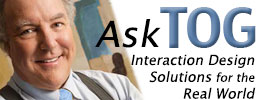Bruce “Tog” Tognazzini is the third principal, along with Jakob Nielsen and Don Norman, at the Nielsen Norman Group, the “dream team” firm specializing in human-computer interaction. Tog was lead designer at WebMD, the super-vertical start-up founded in February, 1996 by Jim Clark, founder of Silicon Graphics and Netscape. Before that, he was Distinguished Engineer for Strategic Technology at Sun Microsystems. During his 14 years at Apple, he designed Apple’s first human interface and wrote eight editions of the Apple Human Interface Guidelines. Tog is a prolific inventor and has published two books, Tog on Interface and Tog on Software Design, as well as co-authoring many others.
Inventor
Tog has 57 patents issued in the areas of human-computer interaction, aviation, radar, eye-tracking, flat panel display information presentation, GPS, portable calendaring, and photography, including a key patent on the electronic viewfinders now ubiquitous on digital cameras (US Patent 7,907,198) and his US Patent 7,062,573, shown in the movie, Avatar. Also invented the Rolling Blackout Password Entry System, placed in the public domain. Never heard of it? It’s standard for password entry on mobile devices, where the last-entered character is displayed for a couple seconds before being replaced by a dot (•••••••e ). It enables the person entering the password to confirm their entry while making life difficult for optical eavesdroppers who must see and record each and every character. To view currently issued US patents, click here.
Consultant
Consulted on interaction design for many companies including:
• 4th Dimension • A.D.A.M. • AA World Services • Adobe • Aldus • Ameritrade • Apple Computer, Inc. • Ashlar • AT&T • Becton-Dickenson • BBC • Boeing • Connections • Enerlogic • General Electric • Generic CAD • Global Perspectives • Gold Disk • Great Plains • Hewlett-Packard • In Control • Inforum • Interactive Software • Intel • Interleaf • International Monetary Fund (IMF) • Intuit • Kaiser Permanente • Kodak • Learningways • Letraset • Lotus • MacMapp • Mapinfo • Mediagenic • Microsoft • Muse • Occam Systems • OCR Systems • On-Technology • OneBigTable • PageMaker • Pastel • Polaroid • Prodigy • Proxima • Saphire Design Systems • Schlumberger • Sculpt 3D • Sensornet • Silicon Beach Software • SPSS • Statoil • Summit Strategies Co. • Symantec Ulysses • Time Arts • TRW • VisiCorp • Wingz • Wordperfect • Xerox
Speaker, Lecturer, and Teacher
Tog is a sought-after speaker. He has delivered keynote addresses at dozens of conferences and conventions around the world, including Siebold, Agenda, and Unix Expo (in America and Europe). Guest lecturer at universities and institutions such as MIT, Stanford, University of California, Moscow State University, University of Zürich, the University of Rome, Centers for Disease Control, Atlanta (CDC), and Georgia Tech (Distinguished Lecturer Series). He has designed and presented tutorials for many organizations and universities, including the UIE User Interface conferences, Computer-Human Interaction Conference of the Association for Computing Machinery, Rice University, and the University of Texas.
Tog regularly presents courses at Nielsen Norman Group events around the world.
Expert Witness
Expert witness on human-computer interaction retained by Lucent in Lucent Technologies Inc. v. Gateway Inc., 07CV2000, U.S. District Court, Southern District of California (San Diego), Lucent patent 4,763,356, testifying on infringement, invalidity, and value. The jury returned a verdict that the patent was valid and Microsoft had infringed, a verdict later upheld in appeal. The original damage award of $365 million was overturned, however, requiring a second trial limited to damages. Of the close to one dozen experts involved in the earlier trial, he was the only one retained for the second trial, this time addressing the single issue of value, explaining to the jury, not the monetary value of the patent, but the high value Lucent’s patented technology offered to the user and thus, by extension, Microsoft. This time, Lucent requested $77 million while Microsoft suggested $5 million as fair and adequate compensation. The jury came back with an award of $77 million.
He has also consulted on several additional cases involving human-computer interaction, including the Kazaa.com case in January, 2006 (Australian Record Industry Association (ARIA) v. Sharman, et. al., Fed. Ct. of Australia), the CAD/CAM patent case in Ashlar Inc. v. SDRC and Diehl Graphsoft, and CEATS, Inc. v Continental Airlines, et. al., in Tyler, TX.
Author
Tog has published scores of papers and articles on human-computer-interaction design, aviation safety, etc., and is sole author of Tog on Interface and Tog on Software Design, both from Addison Wesley. He has co-authored or been a contributing author of several other books including the landmark book, “The Art of Human-Computer Interface Design,” and “Security and Usability,” in which he published to the public domain his 2002 invention, the now-familiar “Rolling Blackout Password Entry System,” which briefly shows each character entered before replacing it with a • character.
Video and film producer/writer/director/performer
He has produced short films and experimental videos, including a short film, “Beach Dreams,” picked up by Home Box Office in 1978. Appeared on several PBS TV shows and documentaries. Created key clips for opening sequence for “The Computer Chronicles.” Wrote and was on-screen performer in “WorldBuilder,” the Apple human interface video on Principles of Macintosh Design. Co-authored, -directed, -executive produced Starfire, the 1992 futurist film that predicted the rise of the World Wide Web. Acted as creative consultant and on-screen talent for a 1996 BBC special on user-centered design, “Computing, an Object-Oriented Approach.”
Pilot
Licensed Private Pilot with experience flying Cessna, Piper, Grob, Diamond, and Lockheed aircraft.

